Hair Fall, also known as alopecia, can be a distressing condition for both men and women. It’s typical to lose between 50 to 100 hairs a day, according to the American Academy of Dermatology (AAD). With about 100,000 hairs on your head, that small loss isn’t noticeable. New hair normally replaces the lost hair, but this doesn’t always happen. Losing hair can have a significant impact on one’s self-esteem and overall well-being. Understanding the causes of hair loss and implementing preventive measures can help individuals maintain healthy hair and potentially slow down or prevent further hair loss.
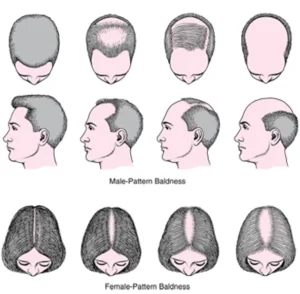
What are the cycles of hair growth?
Hair goes through three cycles:
- The anagen phase (growing phase) can last from two years to eight years. This phase generally refers to about 85% to 90% of the hair on your head.
- The catagen phase (transition phase) is the time that hair follicle shrink and takes about two to three weeks.
- The telogen phase (resting phase) takes about two to four months. At the end of this phase, the hair falls out.
Your shorter hairs — like eyelashes, arm and leg hair, and eyebrows —have a short anagen phase (about one month). Your scalp hair can last up to six years or even longer.
Causes of Hair Fall:
- Genetics: The most common cause of hair loss is a hereditary condition called androgenetic alopecia. In men, this condition is known as male-pattern baldness, while in women, it is called female-pattern baldness. Genetic factors can make hair follicles sensitive to the hormone dihydrotestosterone (DHT), leading to miniaturization of the follicles and eventual hair loss.
- Hormonal Changes: Hormonal imbalances can contribute to hair loss. For example, during pregnancy or menopause, fluctuations in hormone levels can cause temporary hair loss. Conditions such as polycystic ovary syndrome (PCOS) and thyroid disorders can also lead to hair thinning and shedding.
- Medical Conditions: Certain medical conditions and treatments can result in hair loss. These include scalp infections, autoimmune diseases (like alopecia areata), nutritional deficiencies, and chronic illnesses such as diabetes and lupus. Additionally, undergoing chemotherapy or radiation therapy for cancer treatment often leads to temporary hair loss.
- Stress and Lifestyle Factors: Stress, both physical and emotional, can contribute to hair loss. Physical stressors like surgery, severe illness, or rapid weight loss can trigger a type of hair loss called telogen effluvium. Unhealthy lifestyle habits, such as poor nutrition, lack of sleep, and smoking, can also affect hair health and contribute to hair loss.
- Hairstyling Practices: Frequent use of harsh styling tools, tight hairstyles (like ponytails or braids), and excessive heat or chemical treatments can damage the hair shaft and lead to breakage and hair loss over time.
Types of Hair Loss:
There are different types of Hair loss, and various medical conditions that cause hair loss. Here we provide details of some of the most common hair loss conditions. This is not an exhaustive list.
Androgenetic Alopecia: This is caused by both genetic and hormonal factors. It tends to look different between males and females. In men, the typical pattern of hair loss is a receding hair line with loss of hair from the top and front of the head, often in a classic M-shaped pattern. In women, the usual pattern of hair loss is thinning at the crown of the head, with the frontal hairline over the forehead remaining. It is less likely that a woman will experience total baldness as a result of Androgenetic Alopecia.
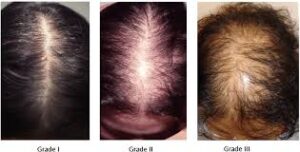
Alopecia Areata (patchy hair loss): This shows up as round or oval patches on the scalp or other places on the body that grow hair. This type can sometimes develop into either Alopecia Totalis (hair loss across the entire scalp) or Alopecia Universalis (hair loss across the entire body), but in most cases it remains patchy and eventually regrowth occurs. For some people with Alopecia Areata the patchy hair loss continues over a long period of time, without ever developing into Alopecia Totalis or Alopecia Universalis: this is sometimes referred to as ‘Persistent Patchy Alopecia Areata’ or ‘Chronic Alopecia Areata’.
Alopecia Areata Totalis: Alopecia Areata Totalis (often known simply as Alopecia Totalis or AT) is characterised by a total loss of all scalp hair. For some people, the hair loss begins as typical Alopecia Areata patches. However, some people experience such rapid hair loss that patches are not seen before most of the scalp hair is lost.

Alopecia Areata Universalis: Alopecia Areata Universalis (often known as simply Alopecia Universalis or AU) is characterised by hair loss across the entire scalp, face (including eyebrows and eyelashes), and the rest of the body (including pubic hair).
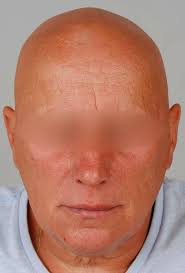
Diffuse Alopecia Areata (Alopecia Areata Incognita): Diffuse Alopecia Areata is characterised by sudden thinning of the hair all over the scalp rather than patches of hair loss. This condition is sometimes also referred to as ‘Alopecia Areata Incognita’. This condition can be hard to diagnose because it looks very similar to other types of hair loss, namely Telogen Effluvium and Androgenetic Alopecia (male or female pattern hair loss).
Alopecia Areata Ophiasis: Alopecia Areata Ophiasis has a specific pattern of hair loss, where hair falls out from the sides and lower back of the scalp. Alopecia Areata Ophiasis can be more difficult to treat because it does not respond as quickly to medication. There is a less common form of this type of alopecia areata, called alopecia areata sisaipho, where the hair is lost from the front of the scalp, forehead and rarely the eyebrows.
Alopecia Barbae: Alopecia Barbae is a form of Alopecia Areata, in which hair loss affects the beard and moustache. Alopecia Barbae can occur only in the beard area, but can also happen alongside hair loss in other areas, such as the scalp. Alopecia Barbae usually causes beard hair to fall out in small circular patches. If more hair is falls out, the circles can begin to overlap. Hair around the edge of the patches sometimes turns white.
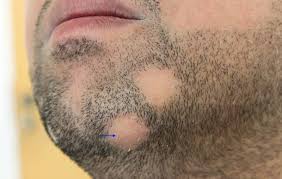
Central Centrifugal Cicatricial Alopecia (Scarring Alopecia) : In CCCA hair tends to start falling out in the middle of the scalp. Hair loss then gradually spreads out from that point. Often, people with CCCA notice hair being more brittle and breaking more easily. Other symptoms include itching, pain or tenderness of the scalp, a spongy texture to the scalp, and flaking or redness of the affected areas.
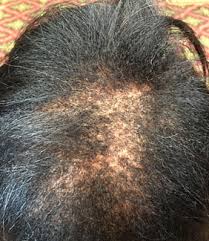
Frontal Fibrosing Alopecia (Scarring Alopecia) : In this, hair loss and scarring make the hairline recede, across the forehead and sideburns of the scalp. The skin of the scalp that is affected often looks normal, but it can look pale or shiny and no hair follicles can be seen. In some cases, redness and scaling can be seen around hair follicles at the edges of the affected scalp. About 50% of people lose hair from their eyebrows and a few may lose hair from their eyelashes and/or other parts of the body. Some people also have skin-coloured bumps on their face, called papules, where the fine hairs on the skin are under attack. Frontal Fibrosing Alopecia often occurs without symptoms, but people can experience an itchy, painful or burning sensation in a band across the frontal hairline.
Lichen Planopilaris (Scarring Alopecia) : Lichen Planopilaris causes smooth, shiny patches of scalp hair loss. No hair follicle openings can be seen in the areas of hair loss. At the edges of these patches, there may be scaliness and redness around the base of each hair, which can make it feel rough. Hairs can be easily pulled out. Lichen Planopilaris often occurs in multiple areas of the scalp, which can join as the condition progresses. The most common areas for Lichen Planopilaris to occur are the sides, front and lower back of the scalp. More diffuse hair loss is uncommon. People do not always have any symptoms of Lichen Planopilaris, but they may experience Itch, Pain, Tenderness, Discomfort & Burning
Traction Alopecia : Traction Alopecia is different from other types of hair loss, like alopecia areata, scarring alopecias and androgenetic alopecia, which are caused by genetic or immune factors. Traction Alopecia is hair loss caused by strain on the hair follicles, often from tight hairstyles. The continuous strain on the hair follicles pulls out strands of hair and can damage or destroy the follicles. Traction Alopecia can happen to anyone who wears their hair pulled back tightly, whether in braids, dreadlocks, or a ponytail. It can also occur when tight headwear (like a cycle helmet) is used in the same way every day, from using chemical relaxers or even hair extensions. Traction Alopecia can happen in any area where the hair is under strain, including the top of the head and the beard area.
Trichotillomania (hair pulling) : Trichotillomania is a condition that leads to an overwhelming urge to pull out hair. Pulling out scalp hair often leaves patchy bald spots, often more on one side of the head than the other, which can cause significant distress and interfere with social life or work. For some people, trichotillomania may be mild and usually manageable. There are several different forms of trichotillomania:
- Focused hair pulling, when someone pulls out hair intentionally. This type of trichotillomania can include specific rituals, including pulling certain types of hair.
- Automatic hair pulling, when people pull hair without being fully conscious of what they are doing.
- Mixed hair pulling, which combines aspects of both types.
Trichotillomania is more common in teenagers and young adults and tends to affect girls more often than boys.
Prevention of Hair Loss:
While some causes of hair loss are beyond our control, there are several preventive measures individuals can take to maintain healthy hair and potentially minimize hair loss:
- Healthy Lifestyle: Adopting a healthy lifestyle can positively impact hair health. Eating a balanced diet rich in vitamins, minerals, and proteins supports hair growth. Regular exercise and stress management techniques, such as meditation or yoga, can help reduce stress levels and promote overall well-being.
- Gentle Hair Care: Treat your hair gently to avoid unnecessary damage. Use a wide-toothed comb or a brush with soft bristles to detangle hair. Avoid excessive heat from styling tools and let your hair air-dry whenever possible. Limit the use of chemical treatments and opt for natural or mild hair care products.
- Avoid Tight Hairstyles: Give your hair a break from tight hairstyles that pull on the hair shaft. Opt for looser styles that distribute tension more evenly and reduce hair breakage.
- Protect from Sun and Environmental Damage: Shield your hair from harmful UV rays by wearing a hat or using hair care products with SPF protection. Minimize exposure to environmental pollutants and chlorine by rinsing your hair thoroughly after swimming.
- Seek Professional Advice: If you notice excessive hair loss or changes in your hair’s appearance, consult a Homoeopathic Physician. They can evaluate your condition, identify any underlying causes, and recommend appropriate treatments or lifestyle modifications.
- Through Homoeopathic Treatment: Homoeopathy offers a great way of treatment in all forms of alopecia via different medicines based on individualistic approach. Different persons with alopecia may receive different medicines depending on their own condition and modality, it is important to consult a professional Homoeopath before taking any medicine. Few medicine such as Arnica, Acid phos., Lycopodium, Cantharis, Jaborandi, Thuja, etc. are well documented medicines for alopecia.
Book An Appointment with us : https://nageswatihomeopathicchikitsalya.in/
Follow us on Instagram for various updates : https://www.instagram.com/nageswati_homoeopathic_clinic/#
